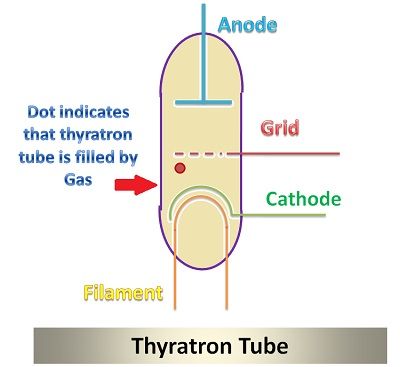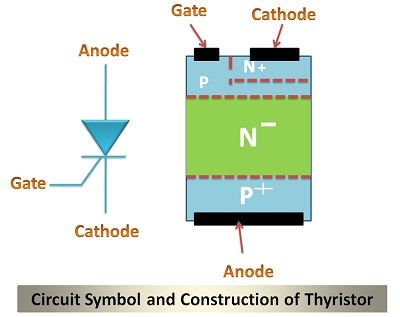The main difference between thyristor and thyratron is that the thyristor is current controlled device while a thyratron is a voltage controlled device. The thyratron is a large tube filled with gases such as mercury, xenon, hydrogen etc. and the conduction increases due to ionization of these gases. The thyristor is a semiconductor device while the thyratron is the voltage controlled device.
Although the thyristor and thyratron both are three terminal devices still the construction of the gate terminal of the thyratron and thyristors are different because one is current controlled semiconductor device while the other one is a non-semiconductor voltage controlled device.
The other important difference between thyristor and thyratron is described with the help of comparison chart in this article.
Content: Thyristor Vs Thyratron
Comparison Chart
| Parameter | Thyratron | Thyristor |
|---|---|---|
| Definition | It is voltage controlled non-semiconductor device used for rectification and switching in electronic circuit. | It is a current controlled semiconductor device which is used for rectification or Switching. |
| Weight | Heavy and requires more space. | Light in weight and require less space. |
| Reliability | Less Reliable | More Reliable |
| Internal Losses | More internal losses | Less internal losses |
| Life of device | Less due to heating of filament. | More as there is no filament. |
| Power supply | It needs large power supply between anode and cathode. | It needs only one low power supply and control signal to perform operation. |
| Turn-On and Turn-Off time | Smaller Turn-On and Turn-Off time | Higher Turn-On and Turn-Off time |
| Cost | More | Less Costly in comparison to thyratron. |
| Accuracy | Less accurate than thyristors. | More accurate than that of thyratrons. |
Definition
Thyratron
A thyratron is a non-semiconductor device which consists of a tube filled with gases. It also consists of a filament, a grid and two other terminals i.e. cathode and anode. Thyratron came into existence after vacuum tubes.

Like vacuum tubes, thyratron can provide rectification and switching in the electronic circuit but they cannot amplify the signal like a vacuum tube do. Besides, the power which a thyratron tube can handle is much greater than that of the vacuum tube.
The dot represented in the thyratron tube is useful for determining that the thyratron tube is filled with gases. The gases which are used in thyratrons are mercury, xenon, neon etc. The conduction in thyratron occurs due to electrons and these gets multiplied several times when the gas present in the tube is ionized.
In this way, a thyratron tube help in achieving rectification and switching task. Apart from large power handling capabilities of thyratron tube, it also has some disadvantages like bulky device and less reliability. As the consequence of drawbacks of the thyratron, thyristors came into existence.
Thyristor
A thyristor is a four-layer semiconductor device formed by combining four layers of P-type and N-type material arranged in an alternative manner. The controlling terminal of the thyristor is called gate terminal. Through this gate terminal, the current supplied to the thyristor is controlled and this decides whether the thyristor is ON or OFF.

A thyristor is a device which is used for rectification of the signal as well as for switching of the signal. It cannot be used to amplify the signal. The four-layer structure of thyristors makes it appropriate for various high power application because of its high current and power rating. Moreover, the use of thyristor in power electronics is due to high power handling capacity.
The thyristor can be understood as the two transistors connected to each other in such a way that the collector of the one is connected to the base of other. Initially, we have to supply voltage to one of the transistors and as soon as it is triggered it will trigger another transistor.
When the voltage is applied to the gate terminal then the gate terminal triggers the circuit to conducting state and thyristor starts rectification.
The crucial point here is we can understand the working of the thyristor with the help of transistor but thyristor cannot participate in amplification of the signal like a transistor.
Key Differences Between Thyristor and Thyratron
- The efficiency plays a major role in differentiating thyristor and thyratron. The efficiency of the thyristor is much better than the efficiency of the thyratron.
- The nature of these two devices is quite different, which creates the key difference between thyristor and thyratron. One is semiconductor device i.e. thyristors while the other is non-semiconductor device i.e.thyratron.
- Thyristors are light in weight as compared to thyratrons. Thyratrons are bulky and they required large space. The reason behind occupying larger space is that the thyratron tube is often confronted by arc-backs and flashover. Thus, to prevent it from such unwanted flashover, it is always kept in the large space.
- The cost of thyratron is much more than that of thyristors, this is because thyratron uses a large tube, filaments while thyristor uses semiconductor material.
- The frequency and magnitude of internal losses also differentiate thyristor and thyratrons. The internal losses are thyristors are less but more in thyratrons.
- The life of thyratron is less than that of the thyristor. This is because the filament used in thyratron tube gets heated due to accelerated electrons striking it. This becomes the reason of its deterioration.
Conclusion
A thyristor is a semiconductor current controlled device while thyratrons are the non-semiconductor voltage controlled devices. The layer structure of thyristor imparts its high reliability and high current rating. On the contrary, thyratrons have become obsolete in the contemporary world due to its bulky nature.
Leave a Reply